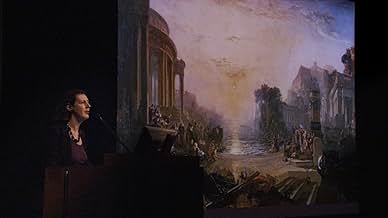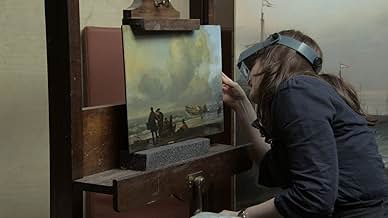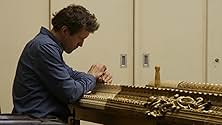IMDb-BEWERTUNG
7,3/10
1737
IHRE BEWERTUNG
Ein Dokumentarfilm, der das Innenleben eines der größten Museen der Welt erforscht: Die National Gallery in London.Ein Dokumentarfilm, der das Innenleben eines der größten Museen der Welt erforscht: Die National Gallery in London.Ein Dokumentarfilm, der das Innenleben eines der größten Museen der Welt erforscht: Die National Gallery in London.
- Regie
- Drehbuch
- Hauptbesetzung
- Auszeichnungen
- 1 Gewinn & 9 Nominierungen insgesamt
Larry Keith
- Self - director of conservation, National Gallery
- (Nicht genannt)
Nicholas Penny
- Self - director of the National Gallery
- (Nicht genannt)
Luke Syson
- Self - curator, National Gallery
- (Nicht genannt)
Empfohlene Bewertungen
For a 3 hour documentary about the National Gallery, this is oddly compelling. I'm really not sure how this got on my watch list, but I'm glad it did. I first visited the National Gallery in my mid-teens. It felt stuffy and I got bored quickly. The art didn't grab me the way things did at The Tate, but I can still recall the feeling of looking at some of those masters and although not thinking 'that looks ace', it was impressive. It's nice to see here that there's voices running the gallery that want to open the gallery to appeal more to the public. This of course being 'proper art' that everyone can think 'well that's good, I can't paint like that', as apposed to the opposite reaction levied at modern art. Not everyone wants that though, there's still the undercurrent of an elitist element present which is frustrating. Some of the nicest stuff in this is the viewers stood looking at the paintings, you experiencing their fascination through their fixation. Especially the packed crowds for the Da Vinci exhibition. The hushed walla through the rooms, people gawking and picking apart the paintings as people have done for hundreds of years. There's some really cool stuff, artwork transferred into almost Braille like pieces for the blind to enjoy, absolutely fabulous! As is the tour guide down on floor with a group of really young kids, telling them about the paintings around them, bustling with energy and enthusiasm. Not least this works simply for the explanation of the exhibits. The stories behind them bringing them to life. The restoration stuff is mind boggling too and sadly isn't covered enough, it's also ironically very much all surface with little explanation to the process... although the X-ray stuff on a Rembrandt is cool and the stuff that's not explained is still very relaxing to watch. Instead there's some behind the scenes stuff which is exceptionally dry. Unedited meetings about how they deal with the London Marathon finishing on their doorstep and how they deal with charitable requests. It's stuff like this that pushes the duration to the 3 hour mark and it's far from entertaining, but it seems the choice has been made to put it all out there for the viewer to muse over... much like the art on the walls. There's some delightful bits though, the art historian filming a piece to camera talking about a Turner, the lighting experts talking about compositions dictated by natural light before we had electricity and the bloke struggling to talk about carving ebony picture frames that reminded Anne* of Porky Pig. Depressingly in another meeting there's talk of budgets, caps on spending, staff reductions and palpable concern over what the future may bring. The figures mentioned are pretty epic, but then as art institutions go, this one is epic. It's been a while. I think I need to go back and visit again.
For those who enjoy the experience of visiting art museums, National Gallery' is a must-see. The brilliant objectivist documentarian Frederick Wiseman captures the iconic British museum from every side imaginable. Over the course of three hours, he offers a grand glimpse of the museum's collection and temporary exhibits as others look or discuss them, from art historians to tour guides. Fixed history and interpretation are celebrated in both Wiseman's camera and the loosely strung scenes of people in the exhibition halls. The movie cuts to various perspectives of the museum, from details of paintings to entire galleries, as people gaze at works. But Wiseman also captures the people operating the museums during PR and budget meetings and, most intriguingly, at work restoring paintings. No one looks at the camera to explain their work and Wiseman never even uses superimposed title cards, yet you will come away enlightened.
I was expecting three hours of viewing paintings; maybe there would be descriptions and opinions.
What we get is much more. It is a real documentary about life in London's National Gallery. I can relate as we have a local (Kimbell Art Museum) and took part in similar activities.
Do not get me wrong, there are plenty of pictures and discussions. They are just part of the overall experience.
You will come away feeling that you are part of the gallery staff and participated in decisions. It is the next best thing to being there. And the three hours presentation in its casual form will leave you wanting more.
What we get is much more. It is a real documentary about life in London's National Gallery. I can relate as we have a local (Kimbell Art Museum) and took part in similar activities.
Do not get me wrong, there are plenty of pictures and discussions. They are just part of the overall experience.
You will come away feeling that you are part of the gallery staff and participated in decisions. It is the next best thing to being there. And the three hours presentation in its casual form will leave you wanting more.
This was another of Wiseman's great films on institutions. The movie takes us inside the world of the National Gallery in London. The film does everything from show us guide lectures to the general public, specific talks for children, an art history discussion of the painting "Boulevard Montparnasse" specifically for blind people (where they feel raised images of the drawing), and talks about restoration. The main focus of the film is a special exhibition they had about Leonardo da Vinci. There is also a focus on the paintings of Hans Holbein, Poussaint, Turner and Titian. There is a very interesting segment where the restorers focus on a portrait of Rembrant, where an x-ray reveals another painting, at a 90º angle, made on the canvas at an earlier time. Discussions about whether and how to "market" the museum and how to project expenses are also shown. The film also shows a discussion with Wayne MacGregror (resident choreographer of the Royal Ballet) about a dance piece that will be performed in front of the Titian paintings and whether the dancers will need a sprung floor (the one in the museum is on concrete).Finally, the films ends with a short excerpt from this piece, danced by Leanne Benjamin and Ed Watson, in front of the Titian painting. Another excellent film by Wiseman and once you have made it past the 1.5 hour mark, by 3 hours, you feel immersed in the National Gallery world.
"National Gallery" (2014, Frederick Wiseman), a documentary about the renowned British art museum, makes a strong case for major arts institutions. With a three-hour running time, we finish with a firm idea of both the inestimable value and fragility of The National Gallery. With a haphazard, seemingly random structure, the documentary shows people regardless of their actual involvement with the museum. We see patrons silently absorbing art; board members discussing their goals; curators discussing philosophy and techniques; janitors; wall painters; a board meeting where the discussion is about an unwelcome public marathon; budget cuts discussed at another board meeting; various educators, various video crews, museum guides analyzing master works; a male and a female nude model separately posing for what appears to be an advanced art class; adventurous Arctic activists bravely hoisting a banner at the museum's entrance; a pianist performing amid priceless paintings and a reasonably erotic, heterosexual ballet dance. Wiseman makes a compelling statement about the worth of visual arts, and it couldn't arrive to this brutal world at a better time.
Curiously, Wiseman does not introduce museum employees with captions or inform the viewer what event is occurring. This helps makes his statement universal. Rather than just a story of the National Gallery, the viewer is encouraged to gain appreciation for his or her local cultural institutions.
There are some memorable segments. I really enjoy the brief excerpts of lectures where experts interpret details in master works. The discussion of Paul Reubens's "Samson and Delilah (1609- 1610)" is interesting. So is the curator's lecture describing a Rembrandt portrait with a hidden second composition of the same subject. One of the senior museum big shots tells a laugh-out-loud joke about Moses and the Ten Commandments. Another museum guide informs a group of adolescents, several of whom are Black, that the Gallery owes its early funding to the Slave Trade. Leonardo da Vinci's power is also expressed or suggested multiple times. Finally, the ballet dance that is staged in the vicinity of two large master works reminds us that visual arts tickle the public's imagination in many ways.
It is an uneven journey, but it finishes with rising interest. "The National Gallery" will likely be enjoyed by artists of many disciplines who wish to be reminded of culture's power. It sure would be nice if the arts flourished in this particularly barbaric period while the world's militaries languished.
Curiously, Wiseman does not introduce museum employees with captions or inform the viewer what event is occurring. This helps makes his statement universal. Rather than just a story of the National Gallery, the viewer is encouraged to gain appreciation for his or her local cultural institutions.
There are some memorable segments. I really enjoy the brief excerpts of lectures where experts interpret details in master works. The discussion of Paul Reubens's "Samson and Delilah (1609- 1610)" is interesting. So is the curator's lecture describing a Rembrandt portrait with a hidden second composition of the same subject. One of the senior museum big shots tells a laugh-out-loud joke about Moses and the Ten Commandments. Another museum guide informs a group of adolescents, several of whom are Black, that the Gallery owes its early funding to the Slave Trade. Leonardo da Vinci's power is also expressed or suggested multiple times. Finally, the ballet dance that is staged in the vicinity of two large master works reminds us that visual arts tickle the public's imagination in many ways.
It is an uneven journey, but it finishes with rising interest. "The National Gallery" will likely be enjoyed by artists of many disciplines who wish to be reminded of culture's power. It sure would be nice if the arts flourished in this particularly barbaric period while the world's militaries languished.
Wusstest du schon
- VerbindungenReferenced in Film Junk Podcast: Episode 493: Predestination (2014)
- SoundtracksSonate pour piano Op. 31 no 3
Music by Ludwig van Beethoven
Performed by Kausikan Rajeshkumar, RCM
dans la cadre de Belle Shenkamn Music Program (correct is "Belle Shenkman music programme")
[Récital]
Top-Auswahl
Melde dich zum Bewerten an und greife auf die Watchlist für personalisierte Empfehlungen zu.
- How long is National Gallery?Powered by Alexa
Details
- Erscheinungsdatum
- Herkunftsländer
- Offizieller Standort
- Sprache
- Auch bekannt als
- 歡迎光臨國家畫廊
- Drehorte
- Produktionsfirmen
- Weitere beteiligte Unternehmen bei IMDbPro anzeigen
Box Office
- Bruttoertrag in den USA und Kanada
- 253.941 $
- Eröffnungswochenende in den USA und in Kanada
- 10.049 $
- 9. Nov. 2014
- Weltweiter Bruttoertrag
- 354.971 $
- Laufzeit3 Stunden
- Farbe
- Seitenverhältnis
- 1.85 : 1
Zu dieser Seite beitragen
Bearbeitung vorschlagen oder fehlenden Inhalt hinzufügen

Oberste Lücke
By what name was National Gallery (2014) officially released in Canada in English?
Antwort






















